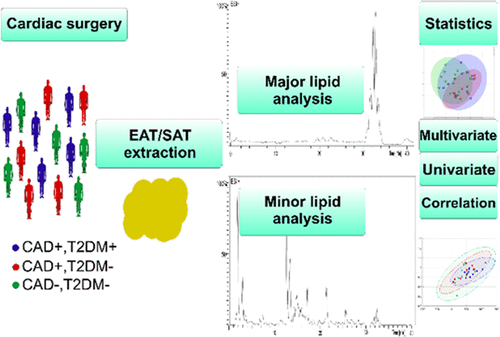当前位置:
X-MOL 学术
›
J. Proteome Res.
›
论文详情
Our official English website, www.x-mol.net, welcomes your
feedback! (Note: you will need to create a separate account there.)
Lipid Profiling in Epicardial and Subcutaneous Adipose Tissue of Patients with Coronary Artery Disease.
Journal of Proteome Research ( IF 3.8 ) Pub Date : 2020-08-24 , DOI: 10.1021/acs.jproteome.0c00269 Petra Tomášová 1, 2 , Martina Čermáková 1 , Helena Pelantová 1 , Marek Vecka 2 , Helena Kratochvílová 3 , Michal Lipš 4 , Jaroslav Lindner 5 , Peter Ivák , Ivan Netuka , Blanka Šedivá 1, 6 , Martin Haluzík 3 , Marek Kuzma 1
Journal of Proteome Research ( IF 3.8 ) Pub Date : 2020-08-24 , DOI: 10.1021/acs.jproteome.0c00269 Petra Tomášová 1, 2 , Martina Čermáková 1 , Helena Pelantová 1 , Marek Vecka 2 , Helena Kratochvílová 3 , Michal Lipš 4 , Jaroslav Lindner 5 , Peter Ivák , Ivan Netuka , Blanka Šedivá 1, 6 , Martin Haluzík 3 , Marek Kuzma 1
Affiliation

|
Coronary artery disease is one of the most frequent causes of morbidity and mortality worldwide. It is even more prevalent in patients with type 2 diabetes mellitus who suffer from obesity and increased accumulation of epicardial fat with a possible contributing role in the development of coronary artery disease. We performed an MS-based lipidomic analysis of subcutaneous and epicardial adipose tissue in 23 patients with coronary artery disease stratified for the presence/absence of type 2 diabetes mellitus and a control group of 13 subjects aiming at identification of factors from epicardial fat contributing to the development of coronary artery disease. The samples of adipose tissues were obtained during elective cardiac surgery. They were extracted and analyzed with and without previous triacylglycerols separation by high-pressure liquid chromatography–mass spectrometry (HPLC-MS). Multivariate and univariate analyses were performed. Lipidomics data were correlated with biochemical parameters. We identified multiple changes in monoacylglycerols, diacylglycerols, triacylglycerols, glycerophosphatidylserines, glycerophosphatidylethanolamines, glycerophosphatidylcholines, ceramides, sphingomyelins, and derivatives of cholesterol. Observed changes included molecules with fatty acids with odd (15:0, 15:1, 17:0, 17:1) and even (10:0, 12:0, 14:0, 16:0, 16:1, 18:0, 18:1, 18:2, 20:4, 20:1, 22:0) fatty acids in both types of adipose tissue. More pronounced changes were detected in epicardial adipose tissue compared to subcutaneous adipose tissue of patients with coronary artery disease and type 2 diabetes. Lipidomic analysis of subcutaneous and epicardial adipose tissue revealed different profiles for patients with coronary artery disease and type 2 diabetes, which might be related to coronary artery disease and the presence of type 2 diabetes.
中文翻译:

冠状动脉疾病患者心外膜和皮下脂肪组织中的脂质谱分析。
冠状动脉疾病是全世界发病率和死亡率最常见的原因之一。它在患有肥胖症和心外膜脂肪积累增加的2型糖尿病患者中更为普遍,并可能在冠状动脉疾病的发展中发挥作用。我们对23例因是否存在2型糖尿病而分层的冠状动脉疾病患者和13例对照组进行了基于MS的皮下和心外膜脂肪组织脂质组学分析,旨在确定心外膜脂肪中促成糖尿病的因素冠状动脉疾病的发展。在择期心脏手术期间获得脂肪组织的样品。通过高压液相色谱-质谱联用(HPLC-MS)提取和分析是否进行三酰基甘油分离。进行了多变量和单变量分析。脂质组学数据与生化参数相关。我们确定了单酰基甘油,二酰基甘油,三酰基甘油,甘油磷脂酰丝氨酸,甘油磷脂酰乙醇胺,甘油磷脂酰胆碱,神经酰胺,鞘磷脂和胆固醇衍生物的多种变化。观察到的变化包括具有奇数(15:0、15:1、17:0、17:1)和偶数(10:0、12:0、14:0、16:0、16:1、18)的脂肪酸分子两种类型的脂肪组织中的脂肪酸:: 0、18:1、18:2、20:4、20:1、22:0)。与患有冠状动脉疾病和2型糖尿病的患者的皮下脂肪组织相比,在心外膜脂肪组织中检测到更明显的变化。皮下和心外膜脂肪组织的脂血学分析显示,冠心病和2型糖尿病患者的血脂谱不同,这可能与冠心病和2型糖尿病的存在有关。
更新日期:2020-10-02
中文翻译:

冠状动脉疾病患者心外膜和皮下脂肪组织中的脂质谱分析。
冠状动脉疾病是全世界发病率和死亡率最常见的原因之一。它在患有肥胖症和心外膜脂肪积累增加的2型糖尿病患者中更为普遍,并可能在冠状动脉疾病的发展中发挥作用。我们对23例因是否存在2型糖尿病而分层的冠状动脉疾病患者和13例对照组进行了基于MS的皮下和心外膜脂肪组织脂质组学分析,旨在确定心外膜脂肪中促成糖尿病的因素冠状动脉疾病的发展。在择期心脏手术期间获得脂肪组织的样品。通过高压液相色谱-质谱联用(HPLC-MS)提取和分析是否进行三酰基甘油分离。进行了多变量和单变量分析。脂质组学数据与生化参数相关。我们确定了单酰基甘油,二酰基甘油,三酰基甘油,甘油磷脂酰丝氨酸,甘油磷脂酰乙醇胺,甘油磷脂酰胆碱,神经酰胺,鞘磷脂和胆固醇衍生物的多种变化。观察到的变化包括具有奇数(15:0、15:1、17:0、17:1)和偶数(10:0、12:0、14:0、16:0、16:1、18)的脂肪酸分子两种类型的脂肪组织中的脂肪酸:: 0、18:1、18:2、20:4、20:1、22:0)。与患有冠状动脉疾病和2型糖尿病的患者的皮下脂肪组织相比,在心外膜脂肪组织中检测到更明显的变化。皮下和心外膜脂肪组织的脂血学分析显示,冠心病和2型糖尿病患者的血脂谱不同,这可能与冠心病和2型糖尿病的存在有关。











































 京公网安备 11010802027423号
京公网安备 11010802027423号